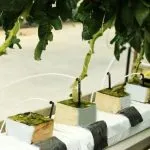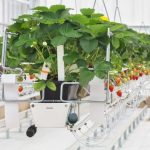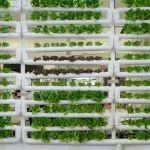Drip system hydroponics is a modern gardening technique that utilizes a water-efficient approach to deliver the necessary nutrients and water directly to the root system of your plants. By incorporating drip irrigation, this method enables you to maintain a thriving garden without relying on soil or excessive water consumption, making it a popular choice among sustainable gardeners and commercial growers alike.
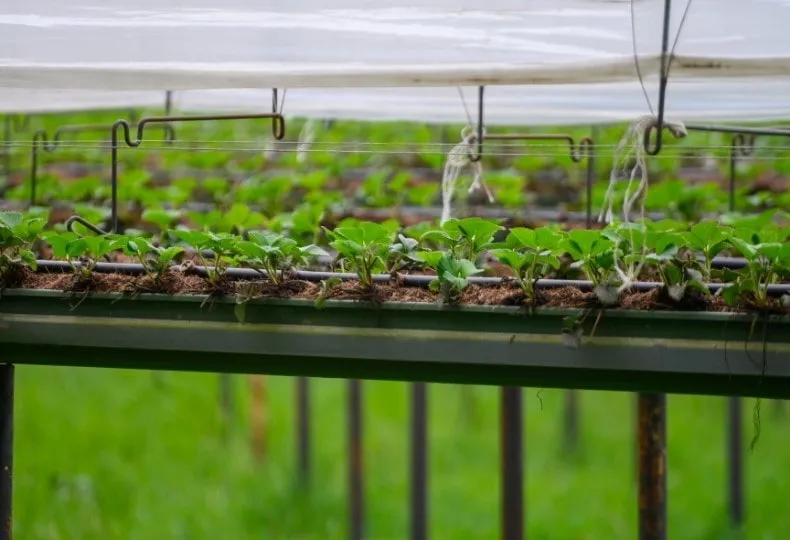
In this type of hydroponic system, you’ll find small emitters placed at the base of your plants, ensuring that they receive a slow and steady supply of nutrient-rich water. This targeted approach reduces waste, promotes healthy plant growth, and allows for easy customization depending on the specific needs of your plants.
As you explore the world of drip system hydroponics, you’ll discover its numerous benefits such as efficient water use, optimal nutrient delivery, and versatility. This gardening method offers a practical solution for those looking to minimize their environmental footprint while still cultivating a flourishing garden.
- How Does A Hydroponic Drip System Work?
- Hydroponic Drip System Diagram
- Hydroponic Drip System Parts
- Types of Drip Systems
- Best Growing Medium For Drip System
- Drip System Hydroponics Pros and Cons
- Monitoring and Maintenance
- Drip System Applications
- Comparing to Other Hydroponic Systems
- Best Plants For Drip System Hydroponics
- Frequently Asked Questions
How Does A Hydroponic Drip System Work?
In a hydroponic drip system, plants receive water and nutrients directly at their roots through a network of feeder lines and drip emitters. This method offers precise control over the amount of moisture and nutrients your plants receive, ensuring that they get exactly what they need to thrive.
To set up a drip system, you’ll first need individual pots or containers for each of your plants. These containers are filled with a growing medium, such as coco coir or perlite, that supports the plants and helps retain moisture.
Next, you’ll need a reservoir for storing the nutrient solution—a mixture of water and essential minerals that provides the plants with everything they require for growth. A pump, placed within the reservoir, circulates the solution through the system and is connected to a timer to automate and regulate the irrigation schedule.
The nutrient solution is then distributed to the plants through a network of feeder lines connected to the pump. These lines, in turn, are outfitted with drip emitters, which slowly and steadily release the solution onto the root area of each plant. This controlled, consistent delivery of water and nutrients ensures that plants receive exactly what they need, when they need it, promoting healthy growth.
A hydroponic drip system is versatile, water-efficient, and suitable for a range of growing spaces and plant types. It can be used for both vertical and horizontal growing systems and is easily scalable to meet your specific gardening needs.
Hydroponic Drip System Diagram
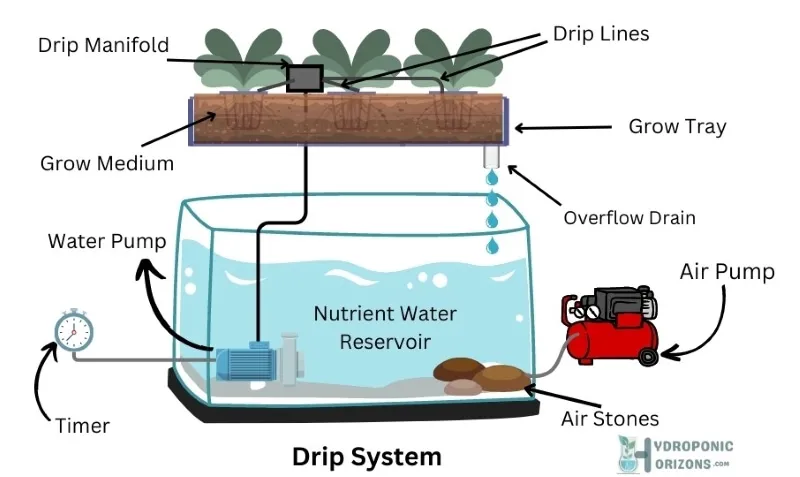
Hydroponic Drip System Parts
Water and Nutrient Reservoir
Your hydroponic drip system requires a water and nutrient reservoir to hold the nutrient solution. This reservoir should be large enough to accommodate the amount of solution needed for your plants. Typically, growers use containers made of food-grade materials to prevent any chemical contamination. In this reservoir, you will mix water and nutrients to create the nutrient solution for your plants.
Pump and Timer
A vital part of your drip system is the water pump, which circulates the nutrient solution from the reservoir to the plants. Pumps come in different sizes and capacities, so choose one that matches the requirements of your hydroponic system. To regulate the flow and frequency of the nutrient solution, use a timer. It is essential to set the right intervals for your specific plants’ needs, as overwatering or underwatering may lead to poor growth.
Drip Emitters and Tubing
Drip emitters are small devices that control the flow of nutrient solution from the tubing to the plants. You need to select the appropriate emitter type and flow rate for your specific hydroponic system and plants. Attach the drip emitters to the tubing at appropriate intervals, and make sure that the tubing itself is laid correctly to ensure even distribution of the nutrient solution. The tubing typically connects the pump to the emitters, so choose a length and diameter suitable for your system’s size and layout.
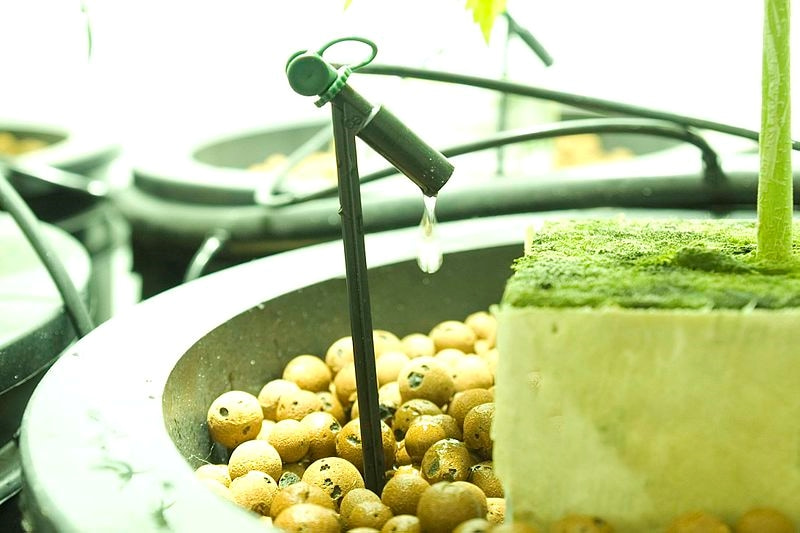
Growing Trays and Medium
To hold your plants, place them in growing trays within the hydroponic system. These trays keep your plants organized and provide an area for the nutrient solution to reach the roots. As for the growing medium, you have several options, including coconut coir, perlite, rock wool, and clay pebbles. The medium’s primary function is to anchor the plants and provide support while allowing for proper air and water circulation around the roots. Be sure to select a medium that suits your plants and their growth stages.
Types of Drip Systems
Recirculating or Recovery Drip System Hydroponics
In a recirculating or recovery drip system, water and nutrients are supplied to your plants and then recaptured, allowing the system to reuse the nutrient solution. This process can be more environmentally friendly and cost-effective as it minimizes the amount of wasted water and nutrients. However, this type of system can be more complex to maintain. You need to carefully monitor your plants, as any imbalances in the water and nutrient solution can be magnified when they are recirculated.
There are a few components you need to make the system work, such as:
- A water pump to circulate the nutrient solution
- Drip emitters to control the flow of water and nutrients to each plant
- A reservoir to collect and hold the nutrient solution
Non-Recovery or Drip-to-Waste Hydroponics
On the other hand, a non-recovery or drip-to-waste hydroponics system does not reuse the nutrient solution. Instead, water and nutrients drip onto the roots of your plants and then drain away, typically into a waste reservoir or directly out of the system. While this method may seem less efficient due to the amount of wasted water and nutrients, it offers some advantages. For example, it’s generally simpler to maintain and there is a lower risk of issues related to water and nutrient imbalances since each application uses fresh nutrient solution.
In a non-recovery system, here are some crucial components:
- A water pump or gravity-based system to deliver the nutrient solution
- Drip emitters for each plant to control water flow
- Drainage system to manage waste nutrient solution
To summarize, in drip systems, there are two main approaches: recirculating (recovery) and non-recovery (drip-to-waste). Each has its advantages and disadvantages, depending on factors like your goals, preferences, and the resources available to you. Both systems require key components such as water pumps, drip emitters, and reservoirs. Depending on your needs, you can decide which system is the best fit for your hydroponic garden.
Best Growing Medium For Drip System
When choosing the best growing medium for your drip system, you’ll want to consider factors such as air circulation, moisture retention, and drainage capabilities. Here are some suitable growing mediums that work well with drip systems:
Coconut coir: This medium is made from the husk of a coconut and is an excellent choice for drip system hydroponics. It has excellent water retention and provides good aeration for the roots, which ensures efficient nutrient delivery.
Rockwool: Made from basalt rock, rockwool is a versatile grow medium that holds water well and offers good aeration. It is suitable for the drip system as it can retain an adequate amount of water and nutrients for the plants.
Perlite: This lightweight, porous volcanic rock is commonly used in hydroponic systems for its ability to hold water and oxygen, making it suitable for a drip system. However, you may need to mix it with other grow media to provide better support for the plants’ roots.
Vermiculite: Similar to perlite, vermiculite is a mineral-based medium that has great water retention and aeration properties. Mixing it with perlite or coconut coir can create an ideal blend for your drip system.
Coco coir: A renewable resource derived from coconut husks, coco coir is a popular choice for drip systems due to its excellent water retention and aeration capabilities. It can be used alone or mixed with other growing media for better results.
Peat: Peat is an organic material commonly used in hydroponic systems, derived from decomposed plant matter. With its water retention and nutrient-holding capabilities, peat can work well in a drip system when mixed with a more aerated medium like perlite.
Experiment with these different growing mediums to find the perfect combination for your drip system and plants. Always consider factors like moisture retention, aeration, and drainage to ensure a successful and thriving hydroponic garden.
Drip System Hydroponics Pros and Cons
Advantages of Drip System Hydroponics
Drip system hydroponics is an active hydroponic system that uses a pump and small emitters to deliver water and nutrient solution directly to your plants’ roots. This method offers several benefits:
- Efficient use of resources: Drip irrigation is known for its efficiency in delivering water and nutrients to the root system, reducing wastage and leakage.
- Precision and control: By using timers and adjustable flow rates, you can easily control the flow of water and nutrients to your plants, ensuring optimal growth conditions.
- Flexible and versatile: This system works well with various growing media and can be adapted for both soil and soil-less mediums.
- Reduces disease: The drip system of hydroponics does a great job at boosting the overall health and toughness of your plants. It’s designed to keep the roots from sitting in stagnant water, which really helps to cut down on problems like rot and bacteria.
- Space-saving: Due to its precise delivery method and scalability, it allows you to grow a larger number of plants in a limited space, making it perfect for vertical gardens.
- Automated and consistent: With the help of timers, the drip system can be automated to deliver consistent amounts of water and nutrients to your plants, reducing the need for constant monitoring and adjustments.
- Adaptable to Uneven Terrain: The flexible design of drip systems can accommodate uneven terrain, allowing for diverse placement options.
- Low Maintenance Requirements: Once set up correctly, drip system hydroponics requires minimal adjustments, making them relatively easy to maintain over time.
Related: The hydroponics bucket drip system is a variation of the drip system, which features a grow tray for multiple plants. Since each plant is grown separately in a bucket, there’s even less chance of disease spreading through the entire system.
Disadvantages and Challenges
Despite its numerous benefits, there are some challenges and disadvantages to using a drip system in hydroponics:
- Gravity dependency: This system relies on gravity to distribute the water and nutrients, which can be a limitation if the plants are not positioned correctly.
- Evaporation and aeration concerns: Drip systems may not provide sufficient aeration for the root zone, which could result in poor plant oxygenation. Additionally, evaporation can become an issue in warmer environments, leading to the loss of essential nutrients.
- Complexity of setup: Setting up the drip system may be more complicated than other hydroponic systems due to its reliance on pumps, timers, and emitter placement.
- Sure, after reviewing the article you provided, here are some additional disadvantages of Drip System Hydroponics:
- System clogging: Since the drip system relies heavily on tiny emitters to distribute water and nutrients directly to the root zone, there’s a high risk of these getting blocked by particles or mineral buildup. This can disrupt nutrient delivery and negatively impact plant health.
- Uneven nutrient distribution: If not set up correctly, there can be uneven distribution of nutrients among plants. Some may receive excess while others might not get enough, leading to inconsistent growth rates and overall poor yield.
- High maintenance: Compared to other hydroponic systems, drip systems often require more maintenance to keep them operating efficiently. Regular checks for leaks, system clogs and correct emitter functioning are essential but time-consuming tasks.
- Dependency on electricity: Similar to several hydroponic setups, drip systems also rely on electricity for pumps and timers. This means that power outages could disrupt the nutrient flow to plants, potentially causing stress or even plant loss if the outage is prolonged.
- Costly setup: Due to its complexity with pumps, timers and emitters, initiating a drip system setup can be financially demanding compared to other simpler hydroponic methods.
Monitoring and Maintenance
To maintain a healthy and efficient drip system hydroponics, it’s essential to monitor and adjust certain parameters regularly. By keeping an eye on pH levels, nutrient concentrations, temperature, and moisture, you’ll ensure that your plants thrive.
Don’t forget to keep an eye on moisture levels. The drip system should provide your plants with a consistent water supply without causing waterlogged roots. Pay attention to the speed of the drippers, as a slow, constant drip will deliver the right amount of moisture to the plant roots without over- or under-watering. Come up with a precise drip system watering schedule that can be tweaked if needed.
Regularly inspect your hydroponic system to keep it functioning efficiently. Clean filters, remove any accumulated debris, and ensure that all drip emitters are clean and working properly. It’s also a good idea to maintain the essential equipment, like the water pump and any monitoring devices, in good working order.
By closely monitoring and maintaining these vital parameters, you’ll be well on your way to providing the ideal environment for your plants to thrive in your drip system hydroponic setup. Remember to stay mindful of your plants’ specific needs, and don’t hesitate to make necessary adjustments to ensure their success.
Drip System Applications
Home Gardening
Drip system hydroponics is perfect for home gardeners looking to save water while maintaining an efficient and productive garden. With a hydroponic drip system, you can control the nutrients and water delivery directly to your plants’ roots, ensuring optimal growth. This system can be used for growing various plants such as vegetables, fruits, and herbs. By using drip hydroponics in your home garden, you not only conserve water but also reduce the risk of plant diseases caused by excess moisture.
Commercial Operations
Commercial growers and hydroponic farms also benefit from implementing drip system hydroponics. Commercial hydroponic farms can maximize their crop yield and quality while minimizing water usage and waste, making it a cost-effective choice for large-scale agricultural ventures. This method is especially useful for commercial operations in arid regions where water conservation is crucial. Drip systems can be scaled up or down depending on the size of the operation, making them a versatile choice for various commercial growing needs.
Vertical Farming
Vertical farming has seen a surge in popularity in recent years, and drip system hydroponics plays an essential role in its success. Vertical farming is a method where plants are grown in multiple stacked layers, providing a space-saving solution for urban and indoor agriculture.
Drip systems work well in vertical farming setups since they can deliver nutrient-rich water directly to each plant at every level. By using hydroponic drip systems, vertical farms can optimize water and nutrient delivery, reducing the risk of overwatering while promoting uniform growth and high yields.
Comparing to Other Hydroponic Systems
In the world of hydroponics, there are various systems that you can choose from. Let’s take a brief look at how drip system hydroponics compares to other popular systems like deep water culture, wick system, and ebb and flow.
Drip System vs. DWC (Deep Water Culture): Drip system hydroponics delivers water and nutrients by dripping them directly onto the plants’ roots, whereas deep water culture has the plants’ roots submerged in a nutrient-rich water solution. While DWC is great for water-loving plants and offers fast growth rates, it requires more water and may be prone to issues like algae growth. On the other hand, the drip system is more water-efficient and easier to manage, making it ideal for plants that don’t require constant water access.
Drip System vs. Wick System: The wick system is a passive hydroponic system, meaning it doesn’t use any pumps or mechanical components. It relies on wicks to transfer water and nutrients from a reservoir to the plants’ roots. The drip system, however, is an active system and uses a pump to deliver water and nutrients to the plants. Drip system hydroponics allows for better control over the water and nutrient delivery while the wick system is simpler and more affordable. But, the wick system may not be suitable for larger plants with high water consumption.
Drip System vs. Ebb and Flow: Also known as flood and drain, the ebb and flow system periodically floods the plant roots with water and nutrients before draining it back to the reservoir. This system requires more equipment, such as a grow tray, a reservoir, and a timer for the pump to control the flooding schedule. In comparison, the drip system is simpler to set up and maintain, and it offers a more consistent nutrient delivery to your plants. However, the ebb and flow system may be more suitable for plants that thrive in wet-dry cycles.
When choosing a hydroponic system, consider factors such as the types of plants you want to grow, your budget, and overall maintenance requirements. Each system has its own pros and cons, and understanding these differences will help you select the one that best suits your needs and gardening style.
Related: Want an overview of each of the seven types of hydroponics systems? You can get it in our Hydroponics 101 guide.
Best Plants For Drip System Hydroponics
Drip system hydroponics is an incredibly versatile growing method, suitable for various types of plants. You can grow almost any plant using this system, but some plants thrive better than others. Here are a few plant options that will flourish in a drip hydroponic setup.
Leafy Greens: You’ll find great success growing leafy greens like spinach, lettuce, kale, and arugula in a drip hydroponic system. These plants quickly absorb nutrients from the water, and their shallow root systems make them ideal candidates for this setup.
Herbs: Flavorful herbs such as basil, cilantro, parsley, and mint love the consistent supply of water and nutrients provided by a drip system. These herbs are easy to grow and maintain, making them perfect for beginners exploring hydroponics.
Strawberries: If you’re looking to grow fruit, strawberries are an excellent choice for drip system hydroponics. They are well-suited for both the recovery and non-recovery drip systems, ensuring an even distribution of nutrient solution to the plants.
Tomatoes: Another popular fruiting plant to grow in a drip hydroponic system is the tomato. With proper maintenance and care, tomatoes can yield an impressive harvest in this setup. Just make sure to provide adequate support for the vines as they grow.
Bell Peppers: Bell peppers adapt well to drip hydroponic systems, providing a colorful and delicious addition to your indoor garden. Regular watering and nutrient delivery help them thrive and produce a healthy harvest.


